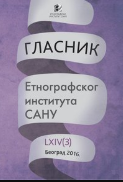Свиларство u Боки Которској (XVIII-XX)
Sericulture in Boka Kotorska Bay (17th-20th)
Author(s): Marija Crnić-PejovićSubject(s): Cultural Anthropology / Ethnology, 17th Century, 18th Century, 19th Century, Pre-WW I & WW I (1900 -1919), Socio-Economic Research
Published by: Етнографски институт САНУ
Keywords: silkworms; plants; production; trees of mulberries; the bay of Kotor;
Summary/Abstract: In the 19th century Boka Kotorska, sericulture — silk-worm breeding and processing -was highly developed. Based on unpublished arhivalia from the Montenegro National Archives, — Records Department of Herceg Novi — and on published materials from the Historic Archives of Kotor and the Historic Archives of Zadar, along with the related literature, the paper deals with the silk-worm breeding, scope of silk production, operation of spinnery mills, planting and cultivation of mulberry trees, whose leaves were used for silk-worm feeding. The Austrian authorities, ranging from the Zadar Regency and the Kotor County Hall, with local councils, through the Silk-Worm Breeding Society and the Bay of Kotor Economy Association, were actively engaged in developing the silk production and enhancing the quality of this economic activity. According to what has been said, it appears that silk-worm breeding was practiced in both rural and urban settlements of the entire Boka Kotorska Bay. The silk-worm breeding entailed the planting of mulberry trees which survived even after the silk-worm breeding had ceased to exist, as mulberry fruit was used to feed pigs and poultry, to make brandy, and because the wood — mulberry lumber — was highly valued in ship building. Mulberry trees were grown in urban settlements as they provided a reliable shade. The silk-worm breeding was discontinued towards and during World War One, whereas the mulberry tree planting persisted until World War Two.
Journal: Гласник Етнографског института САНУ
- Issue Year: LI/2003
- Issue No: 1
- Page Range: 123-134
- Page Count: 12
- Language: Serbian

